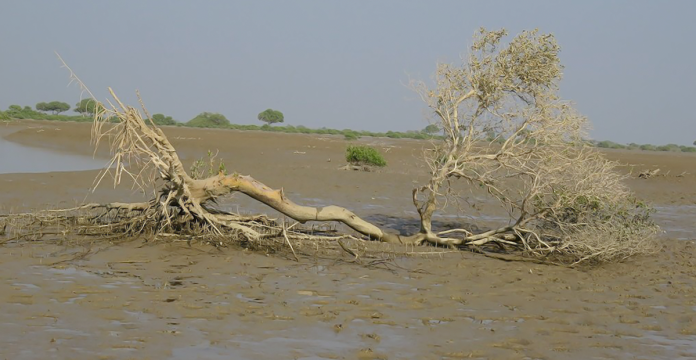Areeba Azhar
“No water, no life. No blue, no green” Sylvia Earle
On 23 March 2023, global leaders and water stakeholders gathered at the United Nations (UN) Headquarters in New York and called for establishing a new UN Convention for the Conservation of River Deltas (UN-CCRD) to address the alarming threat of River Deltas around the world that are shrinking and diminishing, and stressed on the need for their protection. This issue is creating serious impact on the ecosystem and livelihood of the communities around the world.
Pakistan’s Indus River Delta, the fifth largest Delta in the world, is known as the vertebra of Pakistan’s ecology and economy. Indus Delta lies at the heart of Sindh coastal area, comprising the Indus Delta Creek system and the Karachi Coast. A study conducted by a team of five academics lead by Prof Dr Altaf Ali Siyal, at the United States-Pakistan Centre for Advanced Studies in Water (USPCASW) of Mehran University of Engineering and Technology (MUET) in 2018, reveals that the Indus River had seventeen river creeks, now there are only two active creeks, Khobar and Khar. These creeks occupied an area of about 12,900 sq km in 1838, but have shrunk to only 1000 sq km, a reduction of about 92 percent.
The Delta’s degradation can be traced back to 1920s. Prior to that, the Delta water flow reached up to 150 million-acre-feet (MAF) annually and the drainage to sea was about 80 MAF of water. Subsequently, dropping of water levels led to water shortages by the early 1950s. According to the article titled How to Bring the Indus Delta Back to Life Give it Water 2019, written by Zofeen Ebrahim and published in Inter Press Service (IPS), “of the original nearly 6,000 acres of tidal land and mud flats, over 2,500 acres of Indus Delta have slowly been swallowed by the sea over the last 70 years”.
According to Pakistan Institute of Development Economics (PIDE) report (2022): “the country has changed from being a water abundant country till 2021 to a water-stressed country with 0.5 percent of global renewable water resources and ranks 36th in total renewable water resources worldwide. It ranks 14 among the 17 ‘extremely high water-risk’ countries of the world”. In addition, the water availability per capita in Pakistan has dropped from 5,060 cubic meters per annum in 1951 to only 908 cubic meters in 2022. According to UN Development Program (UNDP), “if no urgent action is taken, Pakistan will dry up by 2025”. It is rapidly evolving into a serious crisis, if not controlled in time.
Over the last few decades, the flow in the Indus Delta decreased by 80 percent, which adversely affected the deltaic soil and underground water, converting it to saline. The USPCASW report (2018) found that “up to 78 percent of the water available in the Delta is unfit for drinking purposes”. According to Pakistan Economic Survey 2021-22, “more than 65-70 percent of the population of the country depends on agriculture for its livelihood. Agricultural growth rate suffers badly due to the waste of sweet water that has been constrained by shrinking arable land, climate change, water shortages, and migration of large-scale population and labor from rural to urban areas”.
According to Water-Resources Situation in Pakistan: Challenges and Future Strategies report (2003), “a total of 138 million acres arable area is served by Indus River and its tributaries. Of this, the Indus River alone provides 65 percent of the total river flows annually”. The lack of brick lining in these canals has become a major contributor to raising the groundwater table and the resulting water-logging and salinity, adversely affecting cultivable land on one hand, and reducing the flow of river water in the Delta region.
Salinization is further pronounced in these zones by insufficient drainage. According to the Sindh Water Sector report (2011), the Left Bank Outfall Drain (LBOD) was built on the Indus River in the 1990s to reclaim agricultural lands by addressing the problem of water-logging and salinity failure due to financial and technical problems. According to the article titled Pakistan’s Indus Delta Becoming No-man’s-land, written by Shahid Shah and published in Third Pole 2019, “Only 20 percent sweet water is available underground, as remaining becomes saline, forcing farmers to under irrigate”.
Environmental and socio-economic aspects of the Delta are also under perpetual threat due to coastal erosion and under-cultivation of crop. According to the article titled Indus Second Most Plastic-Polluted River in the World, published in Dawn newspaper of 24 October 2019, “the Indus is the second most plastic-polluted river in the world and produces 164,332 tons of plastic waste annually”. This affects the marine life as well as the lives and livelihoods of people living astride the River. According to the article titled Pakistan’s Indus Delta Becoming No-man’s-land, published in July 2019, “during floods, strong water flows flush most of the sediments from the river Delta into the sea, resulting in uncultivable saline-sodic lands and forcing farmers to migrate to cities”.
According to Pakistan’s Monthly Climate Summary, issued by the Pakistan Meteorological Department in July 2022, “due to the altering conditions of La Niña in 2022, the national monthly rainfall was 181 percent above the average and stood as the record wettest month since 1961. On a regional scale, Sindh (726 percent), Balochistan (590 percent), and Gilgit-Baltistan (233 percent) all witnessed extremely heavy rains, which caused massive flooding and loss of fertile sediments to the sea”.
According to the University of Utah’s Department of Geography in the US, published in Frontiers in Earth Science Journal (2022), “Pakistan, being the most glaciated country, faces water scarcity due to the vulnerability of its primary water source [the Indus River], to changes in climate and demand”. This vulnerability is exacerbated by the altering effects of El Niño and La Niña weather patterns, impacting the glacial regions of northern Pakistan.
According to Pakistan’s Water Resource Management: Ensuring Water Security for Sustainable Development report, issued by the Frontiers Environmental Science Journal (2023), “the country receives about 50-80 percent of its average river flows from glacial melt, while the remaining comes from yearly monsoon rains”.
These factors outlined above are impacting the availability of water, converting Pakistan into a water-stressed country. This accentuating problem highlights the need for the formulation of a long-term policy for the protection of deltaic soil and the restoration of agricultural land. Secondly, there is a need for institutionalized decision-making to address the threats of climate change on water availability.
Thirdly, seawater intrusion warnings should be provided so that concerned departments can take timely action through a well-regulated water management system. However, if the concerned authorities utilize the fertility of the Indus Delta under the Green Pakistan Project, it will be a revival of the Indus Delta Region. Otherwise, the damage to the Indus Delta will be irreversible.
The author is a Research Officer at the Center for International Strategic Studies Sindh.







